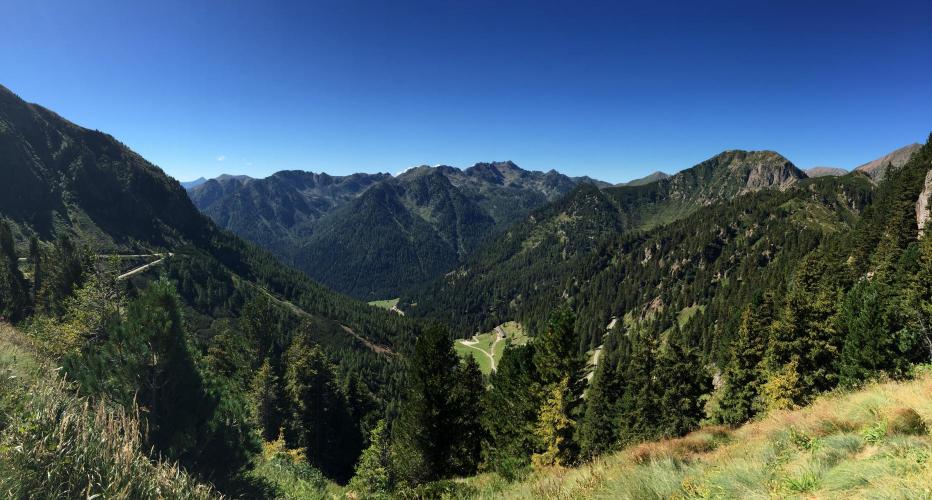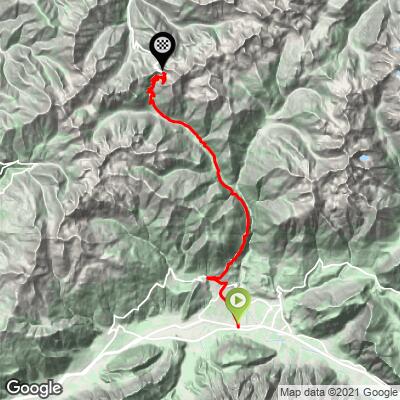Climb Summary
![IMG_5297.JPG]()
Passo Manghen from Telve (south)
This is a very popular and challenging climb about 20 miles / 32 kilometers east of Trento. We began the climb In Castelnuovo which is where the km markers for SP 31 begin (at 0) and continue on up the mountain to the top of Passo Manghen.
![IMG_5004.JPG]()
![IMG_5024.JPG]()
Start of the climb - Castelnuovo roundabout Turn off to Passo Manghen at mile/km 2.5/4
![Grades.JPG]()
![IMG_5115.JPG]()
Km markers go to km 22 (see KM marker slideshow on climb page).
We have some exceptional views to the southwest and southeast of the glacier cut passes that form the valley which SP 228 approaches from the west and SP 60 from the east.
![IMG_5032.JPG]()
![IMG_5033.JPG]()
Westerly view Easterly view
This is a very popular route for cyclists and we encounter many even on the mid-weekday morning that we climbed the mountain.
![IMG_5108.JPG]()
![IMG_5140.JPG]()
From miles/km 8/12.9 to 12/19.3 we pass through meadows with the gentle and calming sound of the cow bells of cattle grazing in the Italian Alps - we love this sound and hear it frequently on our rides into the Italian high country.
![IMG_5079.JPG]()
![IMG_5113.JPG]()
Young girl herding cattle We do not blame that cow - the grade is brutal on this mountain!
![IMG_5289.JPG]()
![IMG_5138.JPG]()
![IMG_5285.JPG]()
![IMG_5141.JPG]()
The roadway is in excellent condition and the serpentine and smooth road at a fairly continuous grade of 8-9% makes this an exceptionally fun descent.
![IMG_5100.JPG]()
![IMG_5142.JPG]()
Much fun on the descent! Ristorante Malga Baessa -
nice spot to stop on the ride down
Giro History
The Giro d’Italia included Passo Manghen for the first time in 1976. At this time, the road to the pass was gravel and unpaved. It is during this climb that great Roger de Vlaeminck abandoned the Giro, and his teammate, Johan de Muynck (race leader after Stage 19):
“The next day had more climbing. Stage twenty went over a climb new to the Giro, the Passo Manghen, a dirt road with a stretch of eighteen percent gradient, followed by Monte Bondone. When de Muynck asked de Vlaeminck and his sidekick de Witte for assurance of their help if he came into difficulty, de Muynck said the two just laughed. On the Manghen, de Vlaeminck, still wearing the purple of the points leader, abandoned. Actually, he threw down his bike and ran into the woods. His gregario Ercole Gualazzini said he ran after him, fruitlessly calling the fast-running cyclocross champion back to the race. Later in the stage de Witte also quit. The Classification leaders all finished the stage together.”
2008 Stage 14 Report (Wikipedia):
24 May 2008 — Verona to Alpe di Pampeago, 195 km (121 mi)
This was the Giro's first stage classified as a mountain stage, though several of those previous had contained selective climbs. The first half of the stage contained three uncategorized rises in elevation, including one to 931 m (3,054 ft). In the stage's final 34 km (21 mi), there were two categorized climbs, the first-category Passo Manghen, featuring gradients of up to 15%, and a second-category summit stage finish at Alpe di Pampeago. The same climb featured in the 2003 Giro d'Italia, where the stage winner was eventual Giro winner Gilberto Simoni. Simoni had said before the stage that he would again try for victory on this climb.[5]
The day's breakaway was large, comprising 13 riders from 11 teams. The only team with more than one rider in the group was Caisse d'Epargne, who had three - Joaquim Rodríguez, José Rujano, and Francisco Pérez. Other notables in the group included Christian Vande Velde, Emanuele Sella, Paolo Bettini, and Jens Voigt. The group's maximum advantage, for the time when they were all together, was 7'40", after 90 km (56 mi). When Sella attacked out of this group to try for maximum mountains points on the Passo Manghen, it was totally shattered, sending some riders, including Vande Velde, back to the peloton and gapping others on the road.
At the top of the Passo Manghen, the following groups had formed: Sella alone in front, followed at 2'42" by Vasil Kiryienka and Rodríguez, then Jure Golčer at 3'00", Rujano at 3'40", Bettini, Voigt, Rinaldo Nocentini, and Charles Wegelius at 5'28", with a group of overall favorites including Alberto Contador, Riccardo Riccò, Gilberto Simoni, and Franco Pellizotti at 10'57", and race leader Giovanni Visconti and his team a further two minutes back. Simoni's Diquigiovanni–Androni team was the one pacing the group of favorites, indicating that Simoni may have been intending to make good on his pre-stage promises to try for the win again.
The groups simplified on the Pampeago climb, with Sella still well ahead out front. 5 km (3.1 mi) from the top, the first on the road 2'24" behind him were Kiryienka, Rodríguez, Rujano, and Bettini, who had consolidated into one group while Golčer, Nocentini, and Wegelius were dropped. The group of overall favorites was ten minutes back, and Visconti was eighteen minutes back, meaning his pink jersey was in jeopardy. Sella rode most of the rest of the climb out of the saddle, continuously adding to his advantage, which was four and a half minutes over Kiryienka in second on the stage. The four chasers behind him did not remain as a cohesive group; Kiryienka and Rodríguez came ahead of Rujano and Bettini, with Kiryienka attacking in the final kilometer to gain 30 seconds over Rodríguez. Bettini scarcely stayed ahead of the fast-charging group of overall favorites, finishing 49 seconds ahead of Denis Menchov, who led that group home. After the stage, Simoni criticized a perceived lack of combativeness in the riders who had been in the same group as him, calling them "a bunch of lambs."
![IMG_5041.JPG]()
Passo Manghen from Molina (north)
The less traveled and “slightly” easier of the 2 climbs.
![]()
Steepest kilometer starts at km 10.1 (12.6%)

 We've partnered with Sherpa-Map.com to bring you the best route planning tool. With a PRO Membership you can use this climb as a reference when creating your route.
We've partnered with Sherpa-Map.com to bring you the best route planning tool. With a PRO Membership you can use this climb as a reference when creating your route. 

